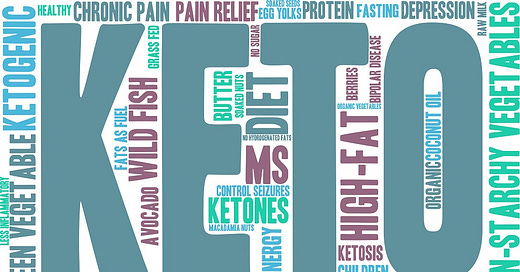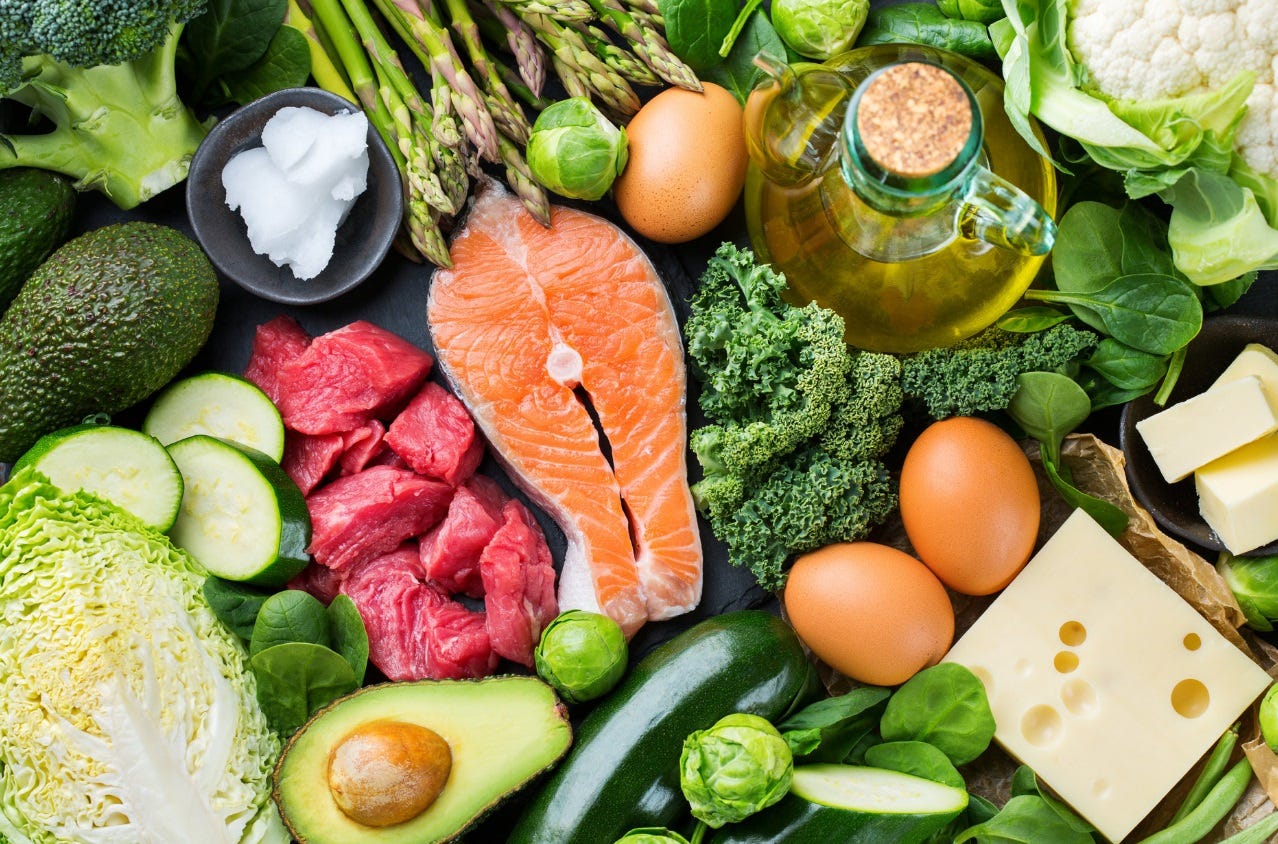“Keto" is short for ketosis, a metabolic process that involves burning fat instead of glucose (carbs) for energy. It sounds simple enough, but the process of getting into and staying in ketosis can be very difficult because there are foods that you can and cannot eat on a ketogenic diet. The health benefits are not yet established for the vast majority of people to stay on this diet for the long term. However, a ketogenic diet is good for a healthy weight loss regimen and getting started into a fat burning metabolic state like we once did in the past!
Carbs are our biological body's preferred form of energy. Although that is changing as we get further into Mitophagy and the newest cycles of Electromagnetic fields! See - Alchemical Wizard 33 : Stimulating Autophagy for Mitochondrial Health! There are a few different metabolic processes in place that can break down glucose molecules (what all carbs are made of) into energy that fuels the body's cells and functions. Which pathway your body chooses to use depends on what and when you last ate, and how much glucose is in your bloodstream versus how much is stored in other tissues (like your liver and your muscles, in the form of glycogen).
If you drastically cut back on eating carbs for a long enough period of time, your body will use up its stored glucose. And, since there's no new glucose coming in, your body is forced to find another way to fuel itself. This is when ketosis happens. Instead of breaking down glucose, your body will start breaking down stored fat and the fat you're eating as energy. When triglycerides (the molecules that make up fat) are broken down, some glucose is released and can be used for energy. In this process, ketones are released as a byproduct, and then eliminated in urine!
Does the Ketogenic Diet work for everyone? And what are the key takeaways from this latest popularity health fad? And how does the Keto Diet go hand in hand with Intermittent Fasting? Let us dive in!
The modern history of the ketogenic diet goes back as far as a hundred years. It was used in the 1920’s to treat epilepsy patients, with very promising results. The very first Western medicine trials using the ketogenic diet to treat epilepsy were carried out in 1911 when two French doctors (Gulep & Marie) treated 20 epileptic children and adults with the so called starvation technique (fasting). The John Hopkins Hospital was the first clinic to treat pediatric epilepsy in particular with the ketogenic diet. However, fasting and ketosis are known to have been a popular treatment method even in Ancient Greece approximately 2500 years ago. Documentation on the matter can be found, for example, in the writings of Hippocrates.
In 1921, a scientist by the name of Woodyatt discovered that fasting or eating a low-carbohydrate diet caused the body to produce acetone and beta-hydroxybutyrate. That same year, Dr. Wilder from the Mayo Clinic defined the term “ketogenic diet” based on this mechanism. This early version of the ketogenic diet involved eating one gram of protein per kilogram of body weight, 10–15 grams of carbohydrates, and acquiring the rest of the daily calorie needs from fat. In terms of macronutrient distribution, this is practically identical to the ketogenic diet in medical use since 2019.
The ketogenic diet was used successfully for two decades after its invention until the treatment of epilepsy was revolutionized by medication. Treatment through diet has been largely forgotten! In the past 20 years, the ketogenic diet has again become popular. Many clinics for example specialize in strict dietary treatment of epilepsy. The effects of the ketogenic diet on many other illnesses have been widely studied. It is increasingly being applied in the treatment of neurological illnesses as well as various metabolic illnesses.
However, the main indication and secret of the ketogenic diet lies in its very effective weight management and the activation of lipid metabolism it offers. Because of this, the popularity of the ketogenic diet has increased exponentially within the past few years. And not just with body builders!
Ketosis refers to the metabolic state in which ketone bodies (and not glucose) form the body’s primary energy source. Ketosis takes place when the consumption of carbohydrates has been repeatedly restricted to less than 50 grams per day, or the overall energy consumed is less than 800 calories per day (VLCD, very low calorie diet). Assuming that the metabolism is functioning normally, the body enters a mild state of ketosis after a solid night’s sleep (8 hours). The slow onset of ketosis after fasting is also directly proportional to abdominal obesity. The more obese the individual, the slower the onset of ketosis.
Ketosis is very natural for the body and part of normal metabolism. In other words, our bodies are “designed” to burn fat for energy and to store excess energy in the adipose tissue. The process is highly functional, particularly when there is insufficient energy available from food. Throughout the Human Avatar’s evolution, ketosis and the activity of lipid metabolism have played a key role in human survival.
But since the development of agriculture, the constant availability of food, food advertising, and simply the presence of food in our everyday lives, especially processed packaged foods, it has caused us to develop in the opposing direction! The sensation of hunger and fasting have become rarer and there are more of us dealing with obesity now, more than ever before. Ketosis, now days is not the default metabolic state for the Human Avatar!
Ketosis is induced incrementally after 3 to 4 days of low calorie intake, fasting or limited carbohydrate intake once the body’s glucose stores (mainly glycogen in the liver and some glycogen in the muscles) are depleted. The activation of ketosis is a normal bodily reaction to secure the energy supply of the central nervous system and the brain when no glucose is available.
The onset of ketosis may be accelerated by consuming medium chain fatty acids (MCT oil). Compared to long chain fatty acids, MCT fatty acids are very rapidly used for energy due to being readily absorbed. MCT fatty acids also move quickly into the mitochondria and unlike long chain fatty acids, they do not require carnitine to oxidize fats. Ketosis may also be activated after intense and prolonged exercise, particularly if only a small amount of carbohydrates was consumed before such exercise!
Okay, now lets cover a few ways of achieving Ketosis!
Before starting a ketogenic diet, slowly begin to limit your intake of carbohydrates. For example, cut out all cereal products and replace them with vegetables, berries, and fruits. Yum!
After 2–3 weeks, limit the intake of carbohydrates to less than 50 grams per day (you will achieve even better results and a faster ketosis if limiting them to less than 20 grams) The term “carbohydrates” here refers to the carbohydrates that impact the blood sugar levels (net carbs), not fiber.
Increase the intake of high quality fat (for example olive oil, avocado, butter, coconut oil and hemp oil, as well as the fat occurring naturally in animal products, if you do such a thing) whilst reducing the intake of carbohydrates.
Walking, running, swimming and bicycling activates lipid metabolism and helps the body switch from burning sugar to burning fat.
Drink plenty of fluids and add high quality electrolytes!
Intermittent fasting significantly accelerates the onset of ketosis!
Limiting energy intake accelerates the onset of ketosis, but extreme calorie restriction and extremely low energy diets are not necessary or recommended!
The fastest way to ketosis is a 3 to 4 day liquid fast after which the body is in a deep state of ketosis! This will require more willpower and perseverance than other methods! See - Alchemical Wizard 2 : Liquid Intermittent Fasting! More ways to ease Ascension Symptoms!
Now, one of the benefits of ketosis, of which there are several, is it facilitates mitochondrial function and reduces oxidative stress in cells! This is what we have been alluding to and periodically have been linking most of these nutritional blogs about!
And please always consider… “Out of the ground, off the vine, off the tree! Food is Medicine. Get your vitamins and supplementation’s from whole foods if you can!” Most vitamin and health supplement brands are owned by pharmaceutical companies, if not, the labs that synthesize the chemical compounds are!
Blessings Everyone as we continue with Holistic Health modalities to inspire confidence as we unlock resources to make this Ascension shift more meliorative! We are Sovereign and We are most defiantly Freeing Ourselves! And Please Stay Hydrated as the SEP’S (Solar Energetic Particles) and Air Showers continue until this adaptation to a higher frequency is completed!
Travis Carper - Ascension Health Coach / Alternative & Holistic Health Service https://www.facebook.com/traviscarper888/ | https://www.linkedin.com/in/traviscarper888/
Additional References :
What Is Ketosis? - https://www.eatingwell.com/article/2060584/what-is-ketosis/
Unlocking the secrets of ketosis - https://brainresilience.stanford.edu/news/unlocking-secrets-ketosis
The Ketogenic Diet: Does it live up to the hype? - https://www.precisionnutrition.com/ketogenic-diet
Ketosis Explained: What It Is, Benefits, And How To Achieve It - https://www.doctorkiltz.com/ketosis/
Beyond weight loss: a review of the therapeutic uses of very-low-carbohydrate (ketogenic) diets - https://www.nature.com/articles/ejcn2013116
The Keto Diet for Beginners - https://ketogenic.com/keto-diet-for-beginners/
Audio References :
The Ketogenic Nutritionist with Temple Stewart, Registered Dietitian -
Who Should Eat Keto and Why? -
The Ketogenic Diet Show - https://www.iheart.com/podcast/263-the-ketogenic-diet-show-28475577/







